Paintings & Art Objects
The paintings and art objects that remain in The Morgan Library & Museum were, with a few exceptions, acquired by its founder Pierpont Morgan. The collection represents the merest fraction of his original holdings, most of which were sold or given away following his death in 1913. The largest group, chiefly consisting of several thousand ancient and medieval objects, was given to the Metropolitan Museum of Art in 1917. The Wadsworth Atheneum in Morgan's native city, Hartford, was another important beneficiary. The pieces that have remained in the Morgan's collection however, were many of Pierpont Morgan's favorite objects.
The value of this collection lies not only in the significance and beauty of the works but in the degree to which they represent the art Morgan acquired during the last twenty years of his life. The chronological span is impressive, ranging from early Mesopotamian and Egyptian through Greco-Roman culture, the Middle Ages, the Renaissance, and beyond. Art of the ancient world is represented by Near Eastern figurines, Egyptian statuettes, and a Roman bronze statue of Eros. Morgan had an extensive collection of Qing porcelain. A Chinese bronze vessel and a fine oxblood vase remain at the Morgan.
The core of the collection, a small but precious hoard of medieval pieces, reflects Morgan's immense interest in the art of this period, evident in the Morgan's great collection of illuminated manuscripts. Therefore, it is only appropriate that the Stavelot Triptych, the Malmesbury Ciborium, the Basin reliquary, and Lichtenthal Casket remained at the Library. Also represented are masterpieces in Renaissance and baroque art. Although Morgan collected some very fine old master paintings by Hans Memling and Perugino, he seems to have focused on the plastic arts. Examples include miniatures on ivory, Lucas Cranach's roundel portraits of Martin Luther and his wife, and a bas-relief of the Virgin and Child by the fifteenth-century Florentine sculptor Antonio Rossellino.
More in Collection Online »
Basin portable shrine
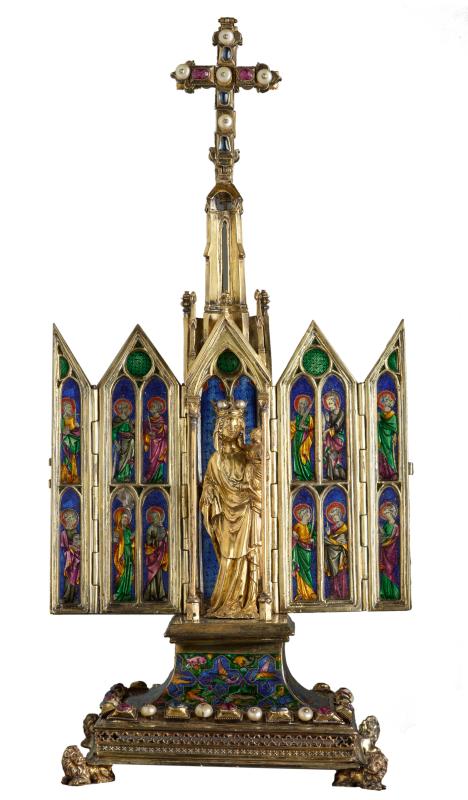
When the shrine (polyptych) is open, a statuette of the crowned Virgin holding the Christ Child stands within the central baldacchin, flanked by the twelve Apostles represented on the four hinged wings. When closed, the wings depict the Last Judgement.
The shrine is named after Thomas Basin (Thomas Bazin), Bishop of Lisieux, Archbishop of Caesarea, who gave the work to the Church of St. John in Utrecht. Basin, who died in 1491, is best known for a "Memoire" of 1453, in which he vindicated Joan of Arc. The shrine was in the church of St. John, where Basin is buried, until it was sold in 1610.
Bust of Alfonso II d'Avalos
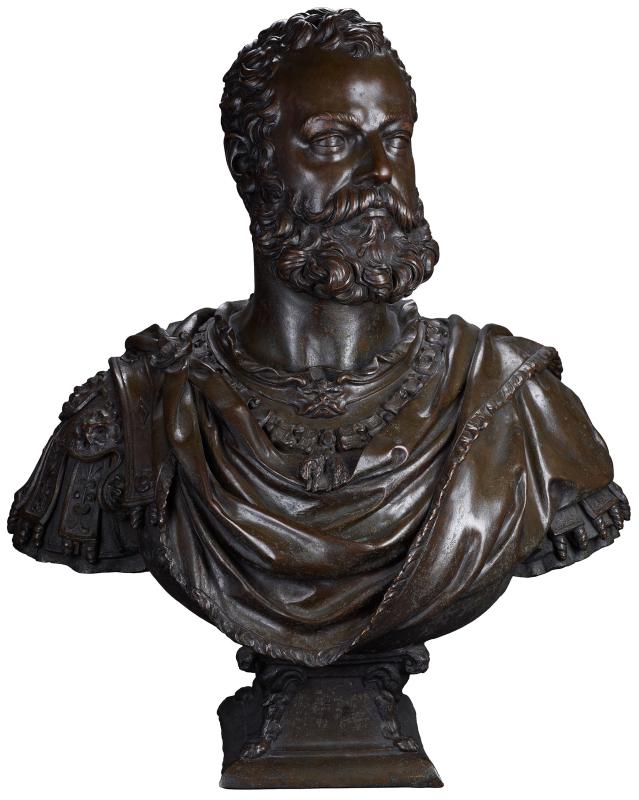
Alfonso II D'Avalos (1502-1546), the marquis of Pescara and Vasto, wielded considerable power as the governor of Milan and commander of imperial forces in Italy under the Holy Roman Emperor Charles v. This portrait bust has been recently recognized as the work of Annibale Fontana, a medalist and engraver who at the end of the sixteenth century was one of the most important Milanese sculptors. The bust, executed after the subject's death, was based on a funerary mask molded by Leone Leoni (1509-1590) in 1546. Walter Cupperi proposes that Fontana executed this bust while in Sicily in 1570-71, while working for Alfonso's son, Francesco Ferdinando. It is listed in the 1571 inventory of his estate, and apparently remained with the family until the 1880s. In 1887 Eugene Plon published it as by Leone Leoni, yet Seligmann sold it to Morgan as the work of Benvenuto Cellini (an attribution that was emphatically marked "No" on the invoice by Morgan's librarian Belle da Costa Greene). It was generally considered as by Leoni until Walter Cupperi convincingly proposed an attribution to Fontana in 2007.
Bust of a Crying Child
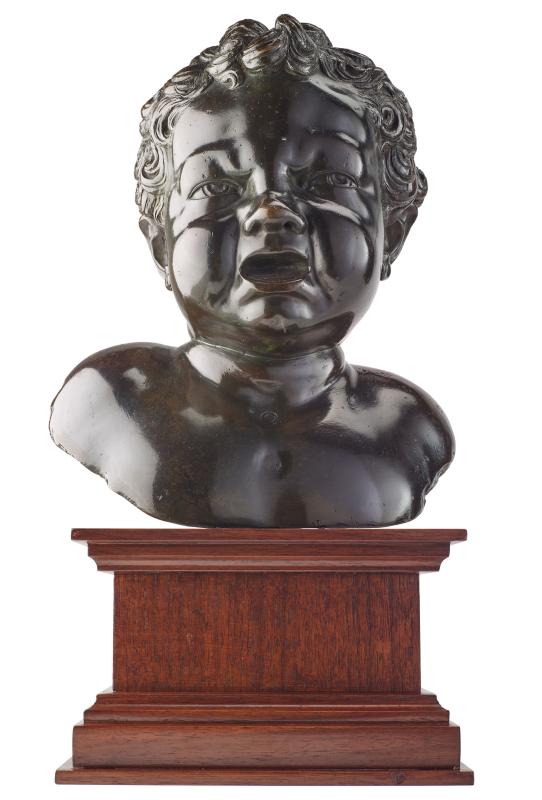
When Pierpont Morgan purchased this bust from Canessa in 1909, it was believed to be the work of Michelangelo. It is actually a cast after a marble bust of a weeping child by the Dutch sculptor Hendrick de Keyser (1565-1621), now in the Statens Museum for Kunst, Copenhagen. The marble was in the Danish Kunstkammeret by 1775 and became part of the Statens Museum collection in 1905, so it is assumed that this cast might date to the late 17th or 18th century. The Morgan's bust came from the collection of the collector-dealer Michele Lazzaroni. Recent scholarship has revealed the extent to which Lazzaroni's stock consisted of forgeries and creative restorations.
Bust of a Woman
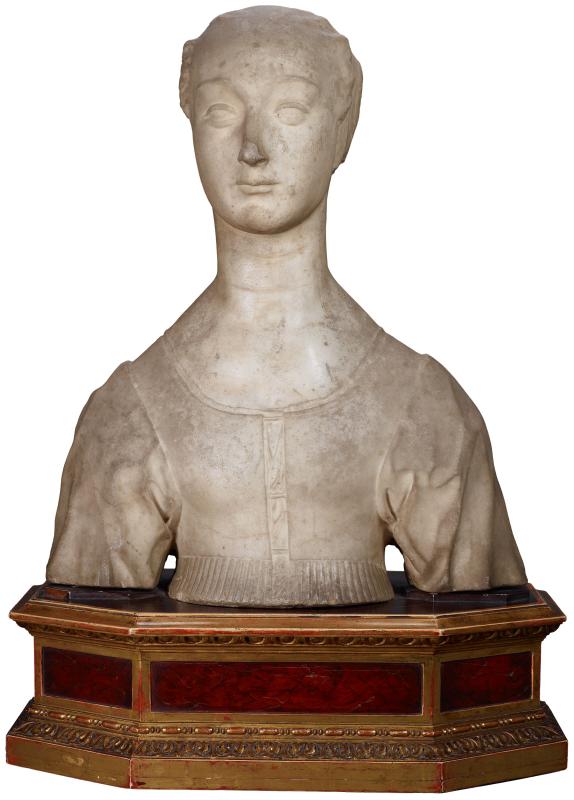
Morgan acquired this bust from Jacques Seligmann, who sold it as the work of Mino da Fiesole (ca. 1429-1484), although it had been published by Wilhelm Bode in 1889 as by Desiderio da Settignano (ca. 1428-1464). Given that the bust came from the Strozzi family collection, Bode posited that it depicts Marietta Strozzi (1448-after 1490), a member of the powerful Florentine banking family. The sitter, however, cannot be identified with any certainty and is unlikely to be Marietta.
Recently, it has been argued that the bust is the work of the Florentine sculptor Gregorio di Lorenzo, whose oeuvre until recently had been attributed to the Master of the Marble Madonnas. New attributions and archival research has revealed that Gregorio and the Master were one and the same. While Gregorio produced a large number of small scale busts and reliefs, scholars have not found this attribution entirely convincing given the curious quality of the carving. Certain aspects of the bust are unusual, including the coarse treatment of the sleeves, the thinness of body in profile, and the square apertures at the side of the head.
Bust of the Christ Child

This bust of a young boy has been traditionally identified as depicting the Christ child, even though the metal halo is a nineteenth-century addition. The bust may once have been coupled with one of the young St. John the Baptist, as such pairings were popular in Florence during the second half of the fifteenth century. Executed in marble, terra-cotta, or stucco, similar busts were produced in sizable numbers in the workshops of artists such as the Rossellino brothers, Bernardo and his younger brother Antonio, as well as Desiderio da Settignano. These devotional images were used both in private settings, for domestic devotion, and as decorative elements in religious buildings.
Bust of Christ Child on wooden base over column. The metal halo is modern.
Candelabrum with Figures of Juno, Minerva, and Venus, Chimeras, and the Three Graces
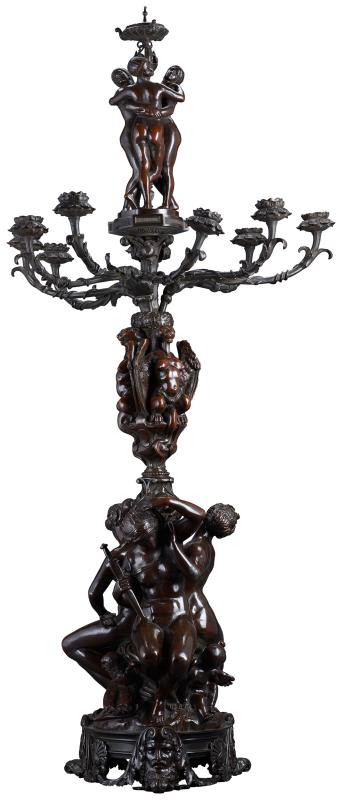
Barye originally designed this candelabrum in 1840 as part of a chimney mantel decoration commissioned by the duke of Montpensier, the youngest son of the French king Louis-Philippe (r. 1830-48). The graceful composition and alluring figures rendered it a success; multiple casts were subsequently made for the art market.
Other pieces included the mate to the candelabrum and a bronze group depicting a scene from Ariosto's epic poem "Orlando Furioso".
Candelabrum for nine candles. At the base of the candelabrum appear Juno, Minerva, and Venus; at the center, three chimeras; and at the top, the Three Graces.
Dish with Putti Dancing and a Winged Putto Playing a Double Flute
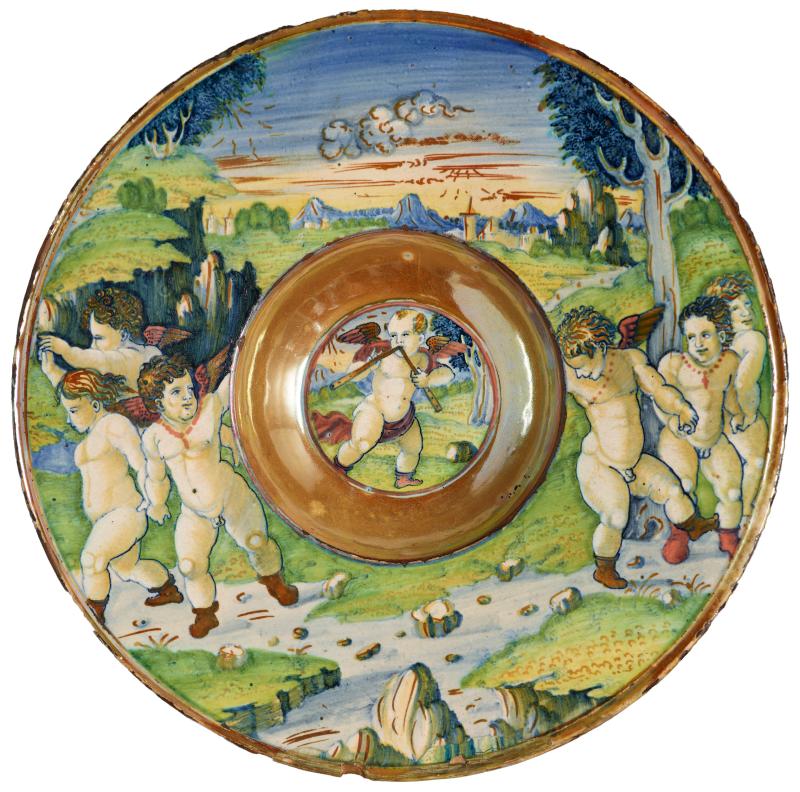
The dancing putti on this dish (tondino) are based on Marcantonio Raimondi's print Dance of Cupids, traditionally considered to be after a drawing by Raphael (now lost) made ca. 1515. The putti wear coral necklaces designed to ward off evil and disease. The dish bears on the reverse the initials Mo Go and the date 1525. It is the work of an accomplished artist active in the workshop of Maestro Giorgio da Gubbio, who was the chief practitioner of the luster technique in Gubbio at the end of the fifteenth and the beginning of the sixteenth century.
Group of putti playing and dancing on field. The putto in the center plays a double flute.
Hercules Carrying the Erymanthean Boar
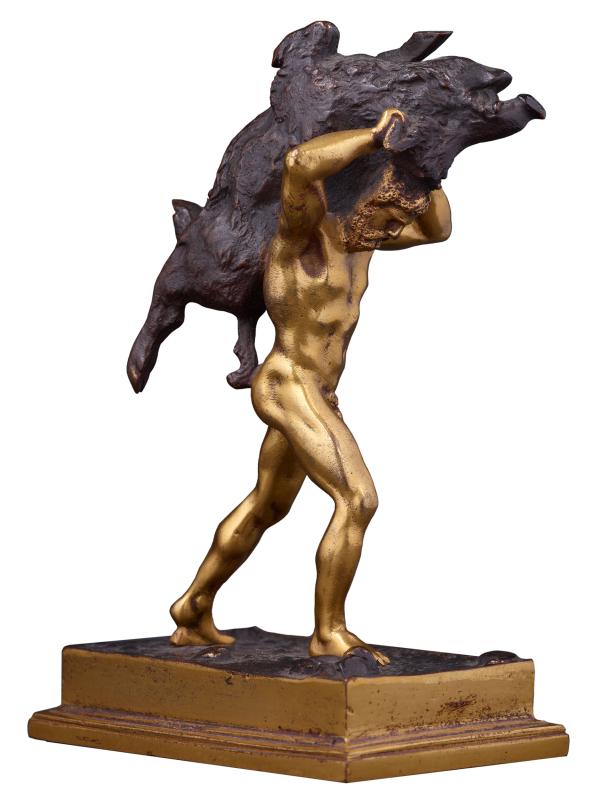
This small bronze figure features the ancient hero Hercules as he carries the subdued Erymanthean Boar across his shoulder. The scene depicts the fourth of the Twelve Labors of Hercules, a series of tasks presumed impossible ordered by King Eurystheus. Antoine-Louis Barye (1796-1875) based this sculpture on a figure from a bronze set of statuettes created by Giambologna (1529-1608) for the Grand Duke Francesco I de'Medici of Tuscany (1541-1587). Barye preserves the animated, dynamic pose characteristic of Giambologna's figure, while adding a brilliant visual and tactile contrast by gilding the muscular body of Hercules, which appears smooth against the coarsely-treated bronze of the beast.
Hercules is gilded. This was the fourth of the Twelve Labors of Hercules.
After Giambologna (Douai 1529-1608 Florence).
Holy Family

Inkstand Surmounted by a Horse

AZ059.1.a (inkstand) AZ059.1.b (lid); AZ059.2 (pen holder)
The sphinxes supporting the base of this inkstand are also found on a candlestick base in the Lehman Collection at the Metropolitan Museum of Art (1975.1.1379) and a tripod candlestick base sold at Christie's, London, 7 December 2006, lot 180 (from the Alfred Beit Foundation). Both works have been loosely associated with Venetian foundries in the late 16th or early 17th century, and have similarities with objects produced in the workshop of Nicolò Roccatagliata. The sphinxes are also similar to those found on objects cast by Joseph de Levis.
Inkstand and lid with handle in the shape of a horse. The four feet supporting the base of the inkstand are comprised of winged harpies or sphinxes; each side of the base contains an armorial shield. These shields bear the arms of the Venetian families Mocenigo; Celci; Nani-Mocenigo; and Querini. The cover is decorated with bands of masques and garlands, surmounted by eagles with wings spread that have been attached. The handle on the lid is formed by a rearing horse whose front hooves rest on a shield bearing a difficult to decipher stemma, perhaps the arms of the Querini family.
Kneeling Female Donor with St. Anne
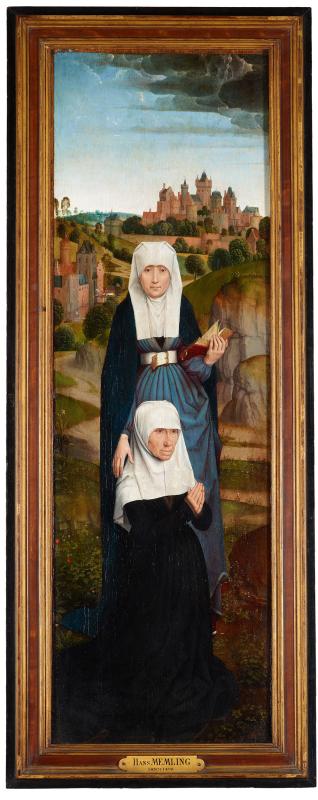
Among Memling's finest early works in this country, these two panels (AZ012.1-2) once formed the inner wings of a triptych. They depict relatives, along with their patron saints, of Jan Crabbe, the fifteenth-century abbot who commissioned the altarpiece. At left, St. Anne stands behind an older, kneeling woman, holding a book in her hands, who is probably Crabbe's mother, Anna. At right, St. William of Maleval appears in armor behind a young man, probably the abbot's half brother, wearing a clerical garb over his knightly armor. The central panel of the triptych, a Crucifixion, is in the Museo Civico, Vicenza, Italy, and the two exterior wing panels are in the Groeningemuseum, Bruges.
In a single image that extends across all three panels--the wings at the Morgan and the central panel now in the Museo Civico, Vicenza--this altarpiece combines a view of the Crucifixion (including the Virgin Mary, St. John the Evangelist, and St. Mary Magdalene to the left of the cross) with images of the donor, his family, and their patron saints. The patron of the work, Jan Crabbe, kneels to the right of the cross, presented by his eponymous saint, John the Baptist, and by Bernard of Clairvaux, the founder of the Cistercian order. Anna Willemzoon, Crabbe's mother, is at left, with St. Anne, while Willem de Winter, Crabbe's much younger half-brother, is at right, presented by St. William. The broad landscape with its gathering storm clouds and the precise details of the plants, clothing, and distant buildings all attest to Memling's technical abilities. What is most extraordinary about the painting, however, is Memling's humanity: perhaps above all in the frank depiction of old age in the faces of St. Bernard and Anna Willemzoon. -- Exhibition Label, from "Hans Memling: Portraiture, Piety, and a Reunited Altarpiece"
Kneeling Male Donor with St. William of Maleval
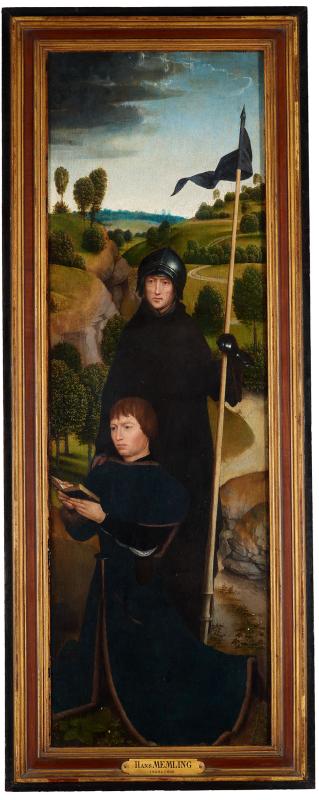
Among Memling's finest early works in this country, these two panels (AZ012.1-2) once formed the inner wings of a triptych. They depict relatives, along with their patron saints, of Jan Crabbe, the fifteenth-century abbot who commissioned the altarpiece. At left, St. Anne stands behind an older, kneeling woman, holding a book in her hands, who is probably Crabbe's mother, Anna. At right, St. William of Maleval appears in armor behind a young man, probably the abbot's half brother, wearing a clerical garb over his knightly armor. The central panel of the triptych, a Crucifixion, is in the Museo Civico, Vicenza, Italy, and the two exterior wing panels are in the Groeningemuseum, Bruges.
In a single image that extends across all three panels--the wings at the Morgan and the central panel now in the Museo Civico, Vicenza--this altarpiece combines a view of the Crucifixion (including the Virgin Mary, St. John the Evangelist, and St. Mary Magdalene to the left of the cross) with images of the donor, his family, and their patron saints. The patron of the work, Jan Crabbe, kneels to the right of the cross, presented by his eponymous saint, John the Baptist, and by Bernard of Clairvaux, the founder of the Cistercian order. Anna Willemzoon, Crabbe's mother, is at left, with St. Anne, while Willem de Winter, Crabbe's much younger half-brother, is at right, presented by St. William. The broad landscape with its gathering storm clouds and the precise details of the plants, clothing, and distant buildings all attest to Memling's technical abilities. What is most extraordinary about the painting, however, is Memling's humanity: perhaps above all in the frank depiction of old age in the faces of St. Bernard and Anna Willemzoon. -- Exhibition Label, from "Hans Memling: Portraiture, Piety, and a Reunited Altarpiece"
Le Roi de Bourges
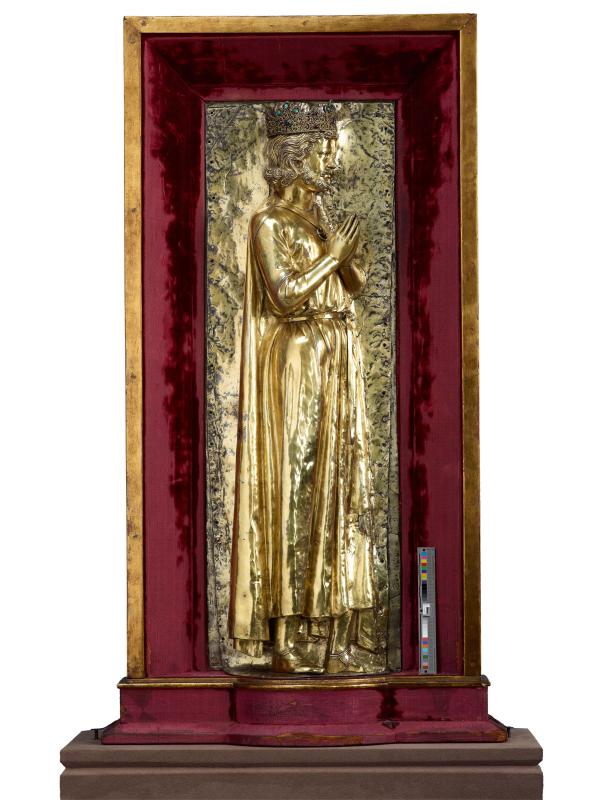
Plaque is mounted on wooden mount covered in red velvet with gilt frame.
The figure is said to have been found in Bourges in 1902 during a demolition and has since been known as "the King of Bourges." Stylistically, it is based on the same type as a mid 13th-century painted stone figure of Childebert in the Louvre, Paris.
The crown may be a nineteenth century addition.
Madonna of the Magnificat
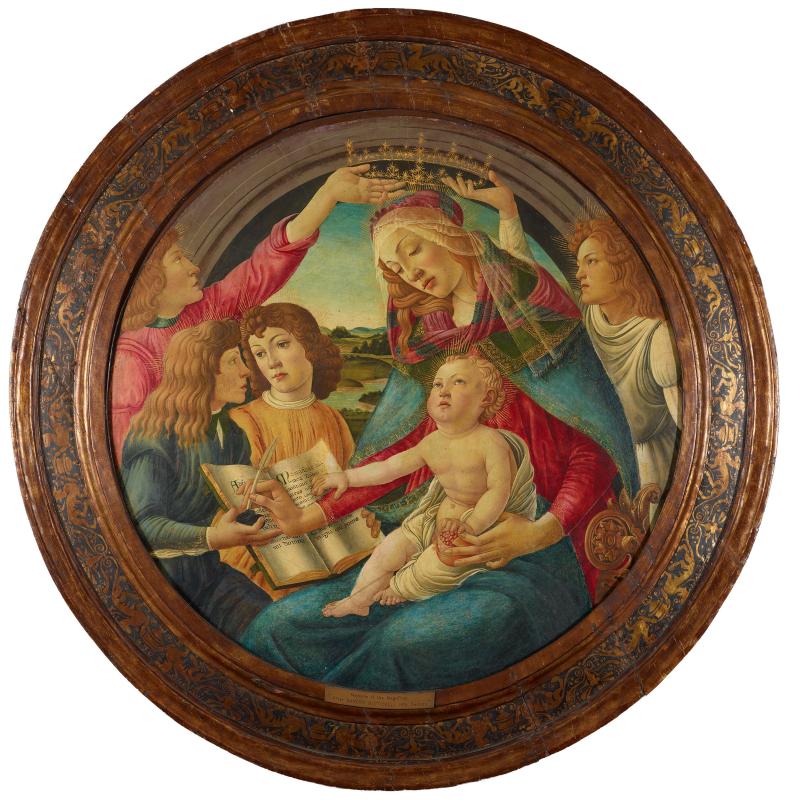
This is one of more than a dozen versions made by contemporaries of Botticelli after an original that the artist painted ca. 1481. The many versions attest to the immediate success of Botticelli's composition and its appeal to contemporary Florentine collectors. The title derives from the opening words of the Virgin's song of exaltation, Magnificat anima mea dominum (My soul doth glorify the Lord), which she is writing in the book before her.
Malmesbury ciborium

The ciborium is decorated with six scenes from the Old Testament paired with six scenes from the New Testament, enclosed within foliated scrolls. The scrolls bear inscriptions, some in verse, referring to the subject depicted.
Miniature portrait of Jane Austen (1775-1817)

Pair of Altar Candlesticks
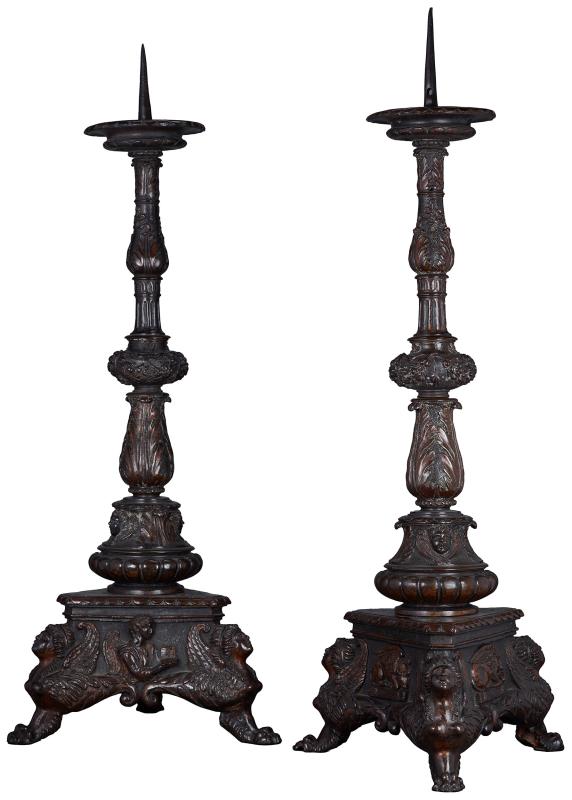
Sphinxes structure the base of each candlestick, one of which bears the winged man symbolic of St. Matthew, while the other bears the ox representing St. Luke. These bronzes were made in Venice ca. 1500-1525 and are part of a larger ensemble, which includes two further pairs of candlesticks, one in the Victoria and Albert Museum, London, and the other in the Metropolitan Museum of Art, New York. Collectively these would have formed an impressive and extensive set of Renaissance altar furniture.
AZ035.1 (St. Luke); AZ035.2 (St. Matthew).
The triangular bases are decorated with sphinxes, the sides are decorated with the angel and ox symbolizing SS Mathew and Luke, and the stems are ornamented with cherubs, acanthus foliage, and rosettes. The pricket candlestick has a metal spike on which the candle rests.
Pair of Candelabra in the form of kneeling angels
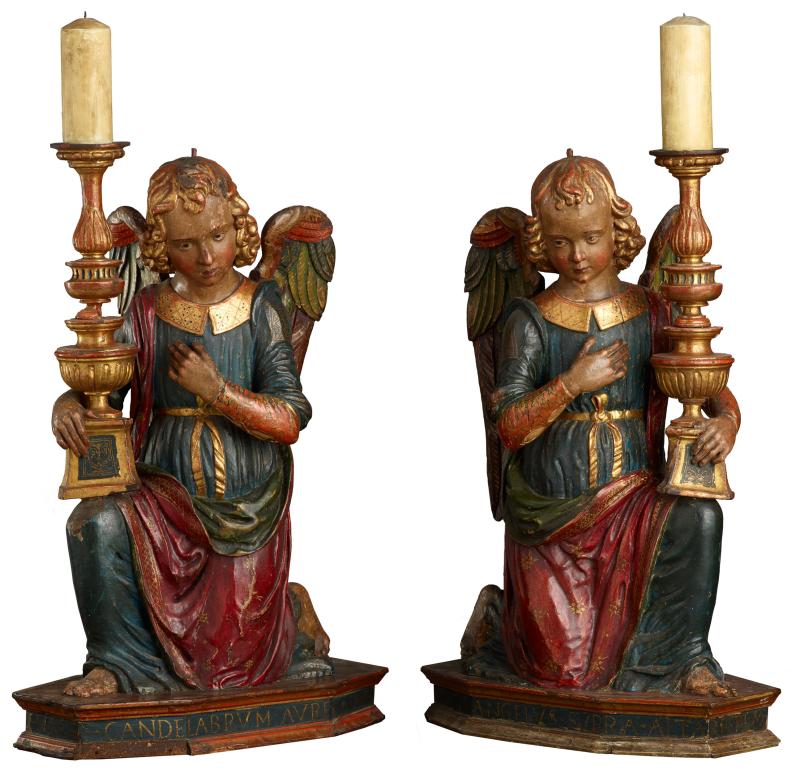
The style of these carved and painted wood figures, with detachable wings inserted into their backs, shows the influence of the early Renaissance Florentine sculptors Benedetto da Maiano (1442-1497) and Andrea della Robbia (1435-1525). Such angels originally would have decorated an altar or the mantel of a tomb. While these two were acquired by Morgan as a pair, they are not by the same carver and likely were executed at different times, perhaps in homage to early Renaissance examples.
Kneeling angels holding a candlestick, one in the proper right hand (AZ026.1A (right wing), AZ026.1B (left wing), AZ026.1C (angel)), the other in the proper left hand (AZ026.2A (right wing), AZ026.2B (left wing), AZ026.2C (angel)). The wings are detachable and are attached to the angels through iron hinges. The angels kneel on plygonal bases.
Pair of Double Cups
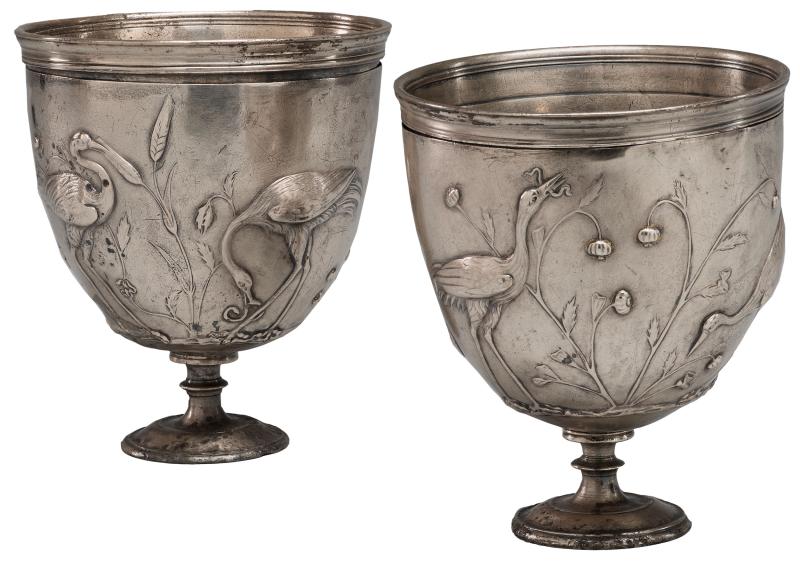
Each cup consists of an inner liner and an outer casing, which is worked in repoussé. The original silver gilt has largely worn away, and the double handles are missing. The decoration consists of cranes feeding among wheat or sorghum, hunting snakes, a lizard, butterflies, and a grasshoper. On one side of one cup, the birds stand beside poppies.
Although the cups were found in Rome, the are believed to be the work of a Greek craftsman.
Probably from the Villa Maxima at Boscoreale.
Pair of Firedog Bases
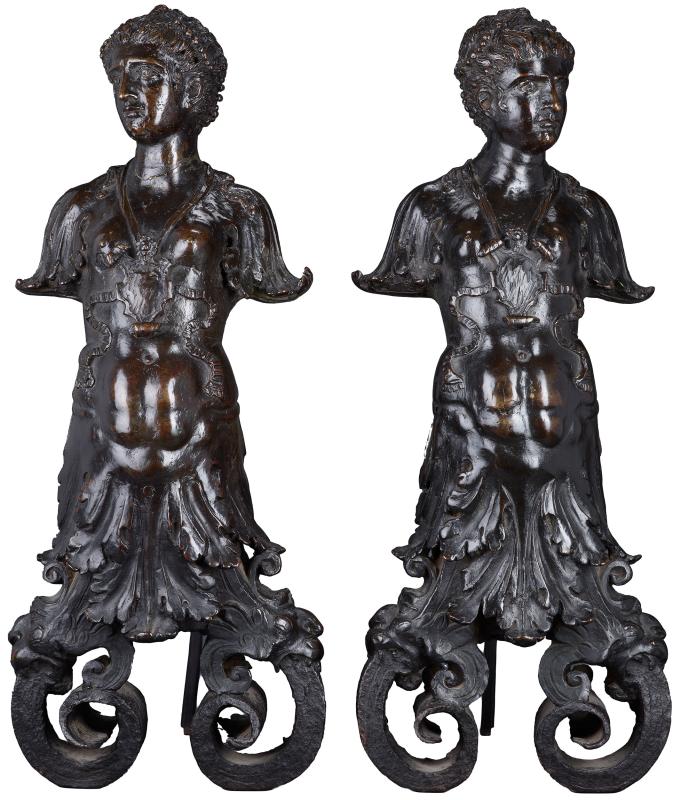
These sphinxlike female figures appear to be the work of an Italian sculptor active in Venice or Padua during the 1520s-30s. It is unlikely that the figures were originally intended to function as andirons; the addition of the lower support, with projecting volutes, and a bar extending behind the figures, were probably added later. It has been proposed that such figures are similar to those that are found on tombs from the period.
The figures were attributed at one point to Verrocchio before Wilhelm Bode assigned them to Jacopo Sansovino. In 1946, Hans Swarzenski described them as Venetian or Paduan from the early 16th century.
Stylistically, these are related to the early work of Andrea Briosco, called Riccio (d. 1532) and Tullio Lombardo. Formerly attributed to Andrea del Verrochio (Florence 1435-1488 Venice) and to Jacopo Sansovino (Florence 1486-1570 Venice).
Fire dogs surmounted by limbless female torsos whose shoulders and bodies terminate in acanthus foliage. A shield, from which the arms have been effaced is suspended from a ribbon around the neck of each. Each one sits on marble base. The base has a hole where the back of the object fits in.
Pair of Saltcellars

These elaborate saltcellars, one decorated with salamanders, the emblem of the French king François I (r. 1515-47), and the other with three interlaced crescents, the insignia of Henri II (r. 1537-59), are rare examples of the extremely fine, complex ceramics produced during the mid-sixteenth century in France, perhaps at Saint-Porchaire, a town in the southwest, or in Paris. Fewer than seventy known examples of Saint-Porchaire ware survive.
Panther

This sinewy bronze animal is of a type popular during the sixteenth century, in part due to a model of a panther by the Dutch sculptor Willem van Tetrode (ca. 1525-before 1588). The patina suggests it was cast in the late sixteenth or seventeenth century. Morgan acquired the bronze in 1911 from the dealer Goldschmidt in Frankfurt merely as an "old bronze sculpture representing a leopard," and no attribution has been ventured in the years since. Thus far, no other casts have been identified.
Another sixteenth century lioness in bronze is known through various casts including those in the Musée du Louvre, Paris, and The Wallace Collection, London. The Morgan's bronze, however, differs in the pose of the animal and the overall patina.
Female panther or leopard standing with her right paw raised and mouth opened.
Pilgrim flask
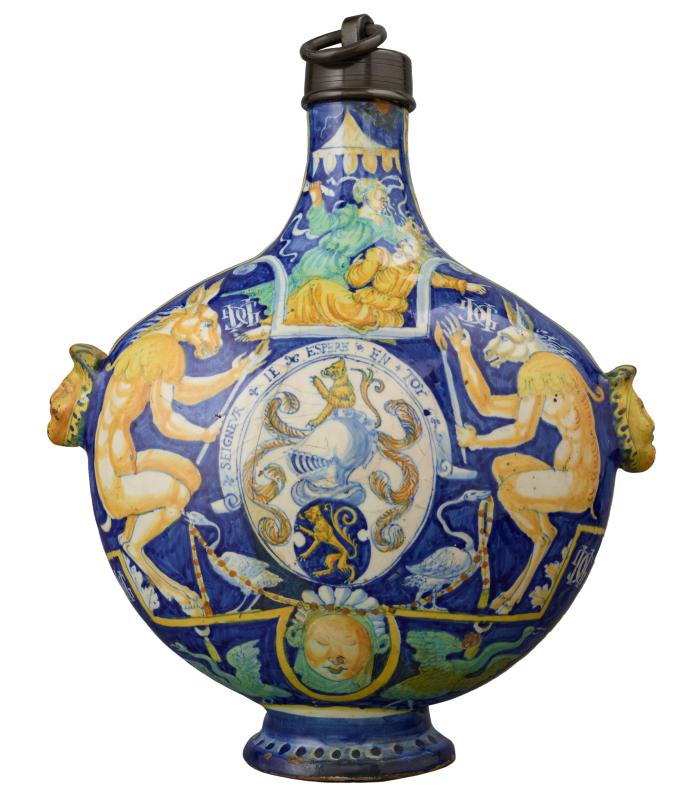
This flask is one of the few known examples of faience ware (tin-glazed pottery) from the southern French city of Nîmes. A Huguenot (French Protestant) deacon, Syjalon often satirized the Catholic Church in his pottery. Here, two fantastic creatures, one with the head of an ass, the other with that of a hare, carry the palms of Catholic martyrs while defecating and vomiting.
There is a lead shot inside the flask.
The arms and motto connect the bottle with a plate in the Victoria and Albert Museum, London, and with Isabeau de la Garde and her grandson Jean de Narbonne, Lord of Trouilles.
A pilgrim bottle by Sigalon in the Metropolitan Museum of Art, which is stylistically related to this flask, bears the date 1581. The motto and monogram are those of Isabeau de la Guarde, married June 6, 1506 to Guillaume de Narbonne, seigneur de Ledignan. Sigalon was a Huguenot, and this piece is decorated with a satire on the Catholic rituals.
Flask decorated in blue, yellow, beige and green with satire on the Catholic ritual. Four initials in each side: two Gs intertwined with Is, one G is upside down. It stands for Isabeau de la Garde.
Plate with Tree and Arms
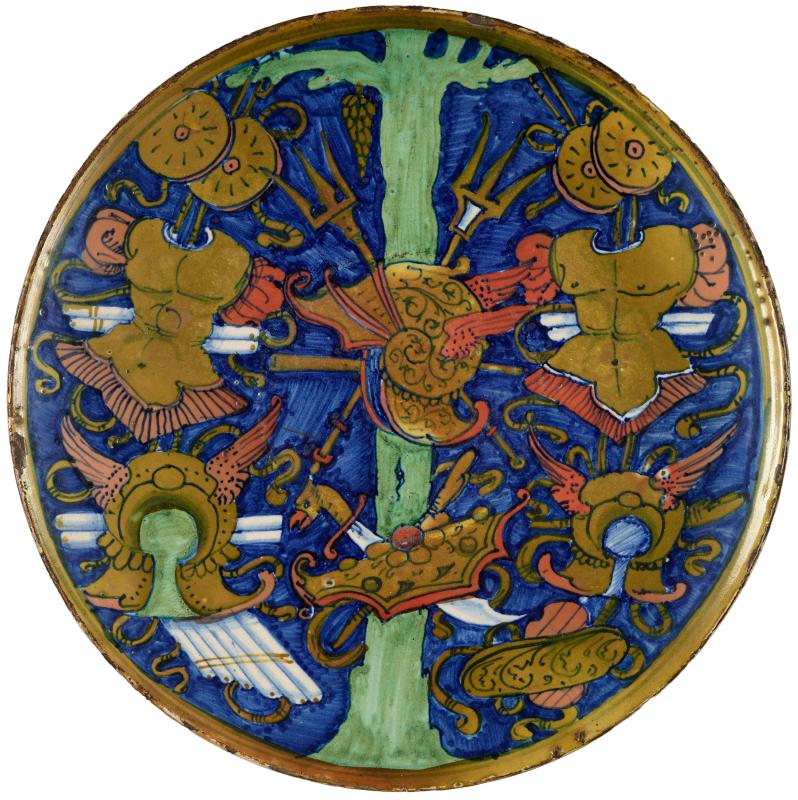
A central green tree divides the roughly symmetrical composition of military trophies on this plate, produced in the workshop of Giorgio da Gubbio, one of the masters of Italian Renaissance majolica ware. Trophies, military arms, armor, musical instruments, and other objects captured after a battle were popular decorative motifs chosen by sixteenth-century majolica painters.
The Library owns another plate by Andreoli (AZ028).
Plate is decorated with a tree trunk charged with a casque, tridents, sword, and shield, surrounded with similar military trophies.
Plate with a Woman in Profile
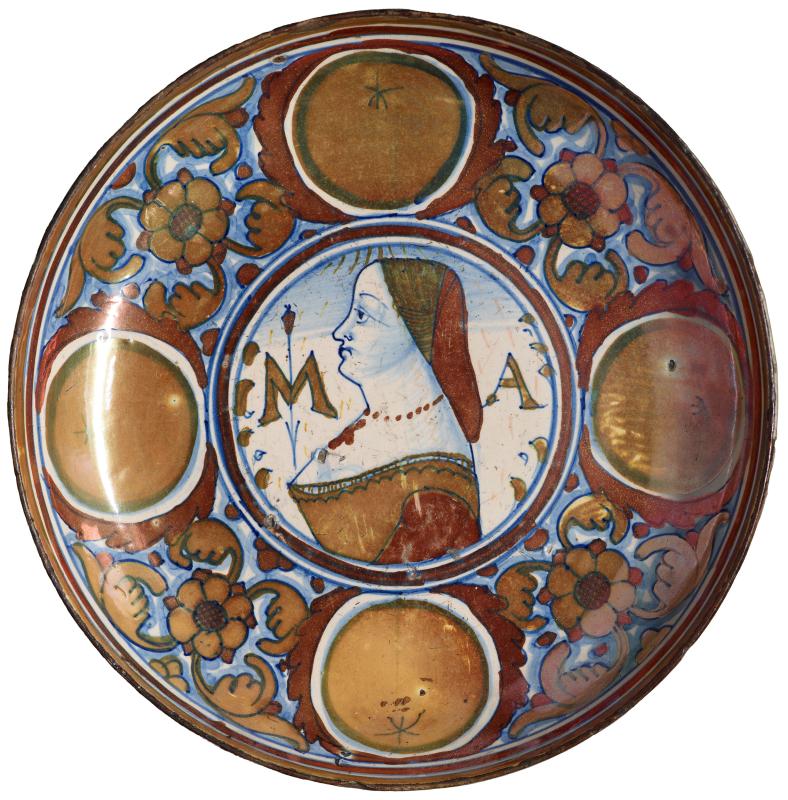
Produced in large numbers during the first half of the sixteenth century, majolica plates and shallow basins with profile busts of women were probably presented as betrothal or wedding gifts. This plate, dated 1519 on the back, is related to basins produced in Deruta, one of the major Italian centers of majolica production during the Renaissance.
Loss of glaze in the back, right side, 14.5 cm long. Other losses throughout.
Majolica fruit plate with side profile bust of a woman between the letters M and A. Decorated with beige, copper, gold, and blue.
Plate with a Woman in Profile
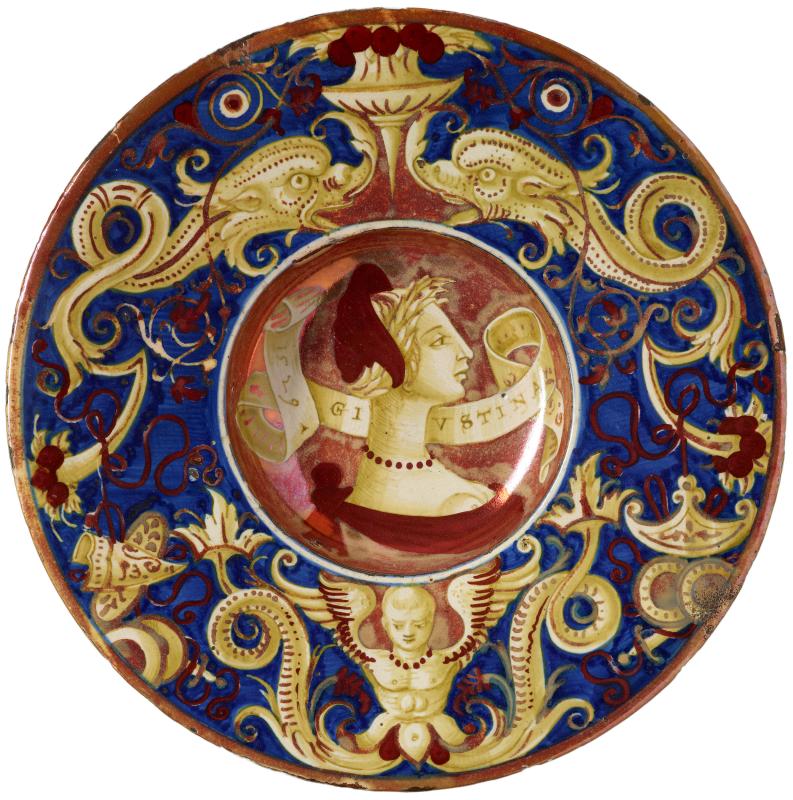
Dated 1529, this plate-depicting a woman identified by the inscribed scroll simply as Giustina - is typical of those produced in Italy during the Renaissance and may have been part of a larger service that commemorated a special occasion, perhaps a wedding.
The Library owns another plate by Andreoli, signed and dated 1519 (AZ030).
Polyptych with Scenes from the Life of Christ, the Life of the Virgin, and Saints
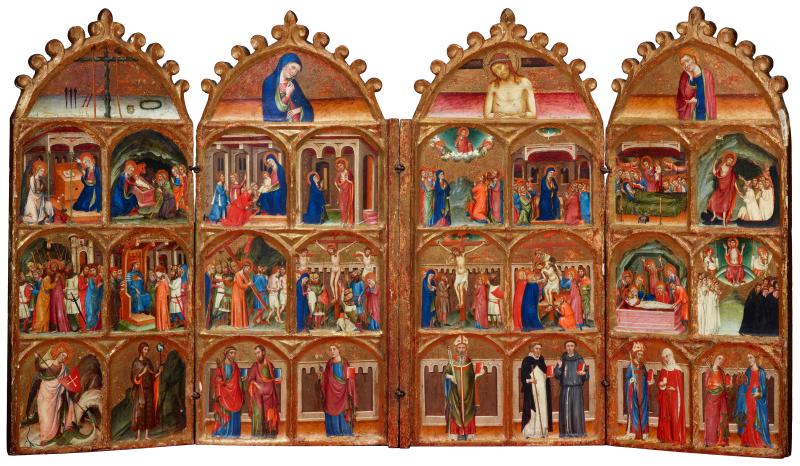
On four panels.
An excellent example of Gothic painting from Catalonia, this polyptych has been recently attributed to the workshop of Ferrer Bassa. It may have been executed by Bassa's son Arnau based on Ferrer's design. Evocative of contemporary Italian painting, the four panels of this altarpiece depict scenes from the life of the Virgin (at the top), the Passion of Christ (in the center row), and saints (at the bottom). The lunettes above depict the instruments of the Passion, the mourning Virgin, Christ as the Man of Sorrows (one of the earliest examples in Spanish painting), and the mourning St. John.
The panels are surmounted by lunettes illustrating the following: (1) the Instruments of the Passion "Arma Christi", (2) the Mourning Virgin, (3) the Man of Sorrows "Imago Pietatis" (one of the earliest examples of this image in Spanish painting; inscribed PIETAS CRI [i.e. Chrisit]), (4) St. John Mourning.
Horizontally, proceeding from left to right, and top to bottom, the scenes depict: In the top row, scenes primarily devoted to the Virgin (Annunciation; Adoration of Shepherds; Adoration of Magi; Christ Appearing to the Virgin after the Resurrection; Ascension; Pentecost; Death of the Virgin; Harrowing of Hell (Christ's Descent into Limbo?)), followed by seven scenes from the Passion of Christ (Betrayal; Christ before Pilate; Carrying of the Cross; the Virgin offering Her veil as a loincloth for the Crucified Christ and Stephaton offering the Vinegar to Christ; the Blindess of Longinus cured by the Blood from Christ's Side; Descent from the Cross; Entombment). The last scene in this row is a Last Judgement, with the Blessed wearing white habits (perhaps Cistercians) and the Damned black ones (Benedectines?).
In the bottom row are standing figures of twelve saints, some of whom are grouped in pairs (St. Michael; St. John the Baptist; St. Peter (with rather strange-looking key) and St. Paul; St. John the Evangelist? (Male saint with flower (lily?)); St. Nicholas? [inscribed ..C..O..]; St. Dominic and St. Francis; St. Augustine? (bishop saint; inscribed..S..E..T..N..S.. (?)) St. Magdalene? (female saint with chain [inscribed ..S.M..HO..]; Female martyr with palm (St. Thecla?) and St. Catherine of Alexandria.
Portrait Bust of A Young Girl Wearing a Beret
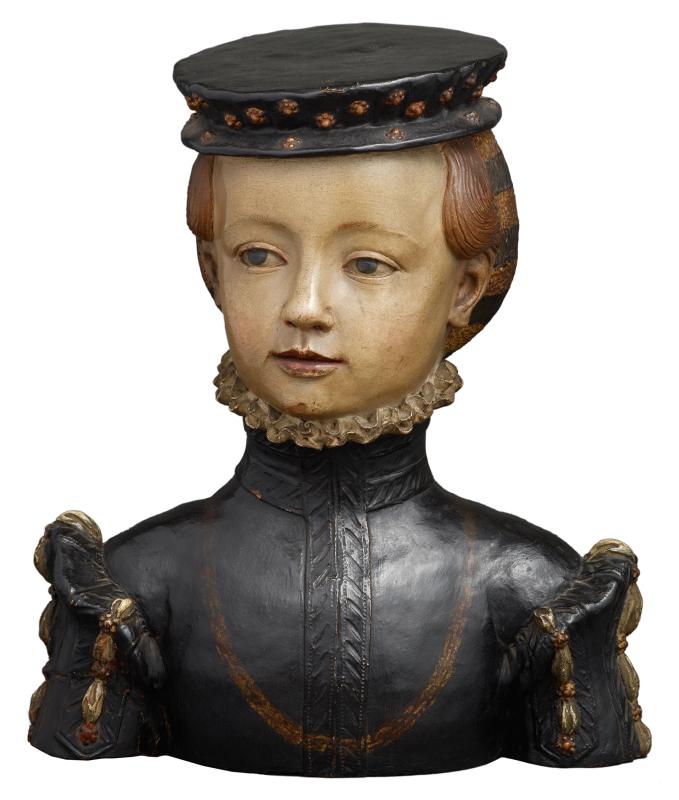
In a letter dated 14 June 2008, Hanne Honnens de Lichtenberg confirmed that the bust could be by Johann Gregor van der Schardt (?1530/31-after 1581), as was first suggested by Jörg Rasmussen in 1975.
Bust of young woman wearing a beret and a high collar dress.
Portrait of J. P. Morgan, Jr. (1867-1943) in a Cambridge Robe
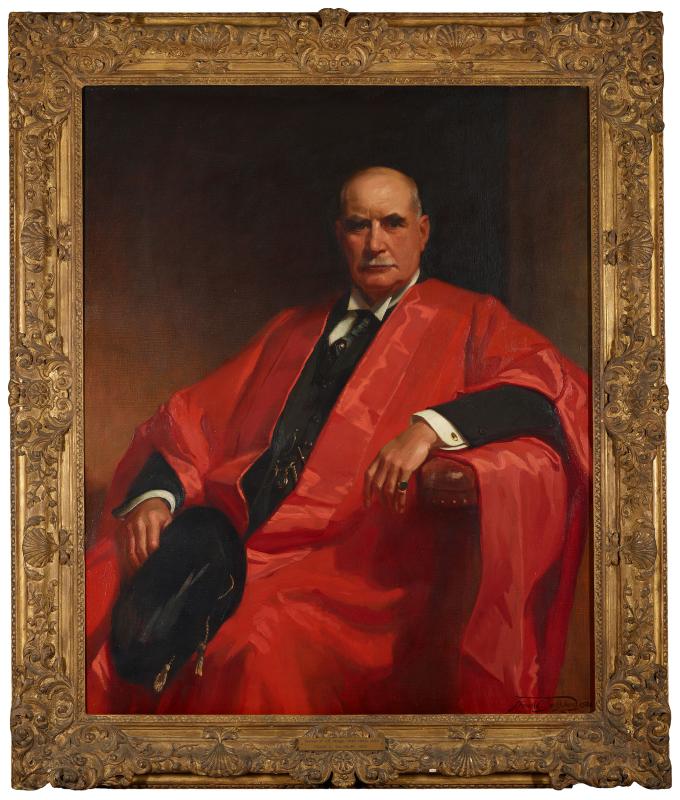
This portrait depicts J. P. Morgan, Jr., Pierpont Morgan's son and a founder of this institution, wearing the robes of a Doctor of Laws, an honorary degree conferred by Cambridge University in 1919. The degree was a gesture of gratitude to the younger Morgan, who, as head of the firm J.P. Morgan & Co., provided financial support to the Allies during the First World War.
Portrait of Pierpont Morgan
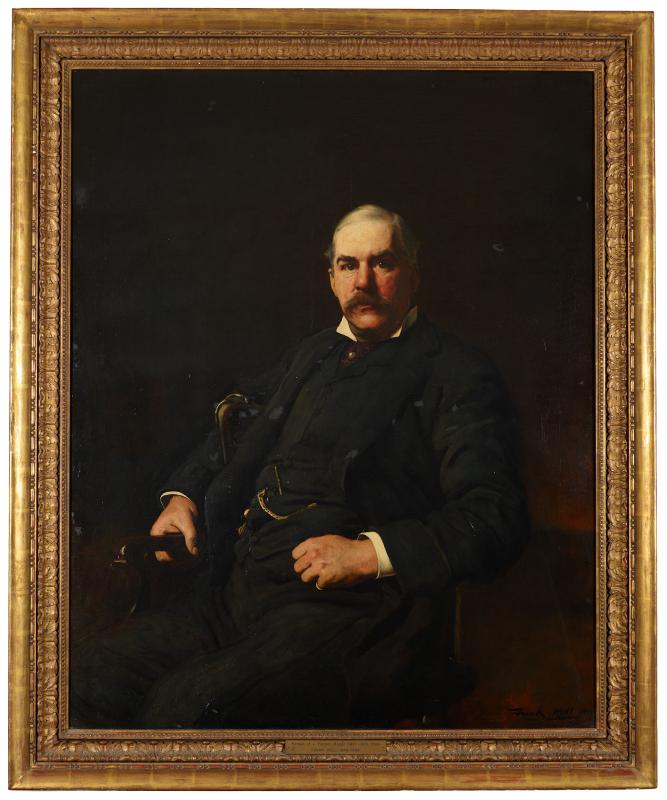
Already one of the world's most prominent bankers, Pierpont Morgan was fifty-two years old when he sat for this portrait. Holl diverted attention from Morgan's skin condition, called rhinophyma, which reddened and inflamed his nose. The banker was so fond of the work he gave photographs of it to friends.
Portrait of a Knight of Malta
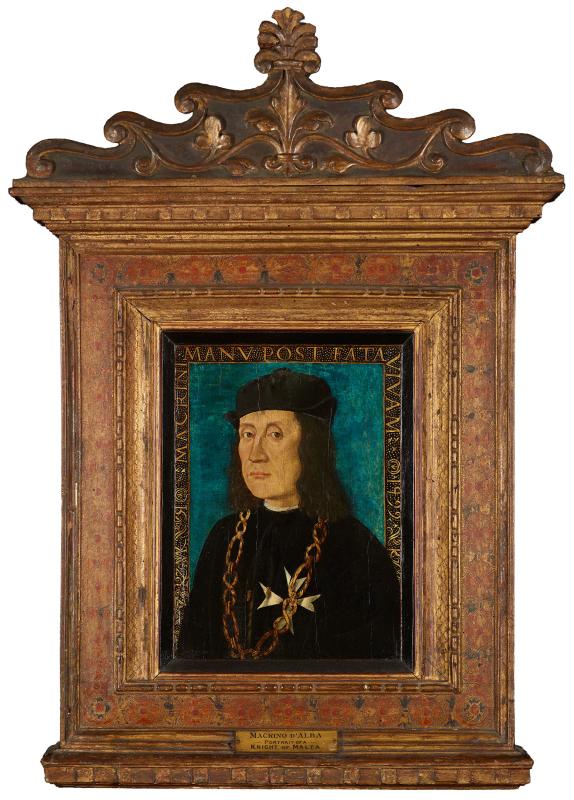
The sitter wears the white cross of the Order of Malta, one of the oldest lay religious orders, whose fifteenth-century members were Catholic, of noble birth, and devoted to works of virtue and charity. He may be Benvenuto San Giorgio of Biandrate (1450-1527), a nobleman, papal ambassador, and knight of the order since 1480. The dated inscription in the border reads By the hand of Macrino I shall live after death 1499.
Portrait of the knight wearing a black outfit and black hat. He has a gold chain around his neck and the Malta cross in white pinned to his shirt.
Portrait of a Man

The unidentified sitter in this portrait, painted in Venice in the workshop of Domenico Tintoretto, son of the more famous Jacopo, is believed to be a Moorish ambassador to the Venetian court. The sitter is dressed, however, in European costume, although the white sash around his waist is less typical of Venetian dress. The rectangular package on the table next to him, wrapped in white and secured with a wax seal, may indicate his role as a diplomat or an envoy. According to contemporary sources, Domenico's studio was often visited by diplomats commissioning portraits.
Portrait of a Man with a Pink
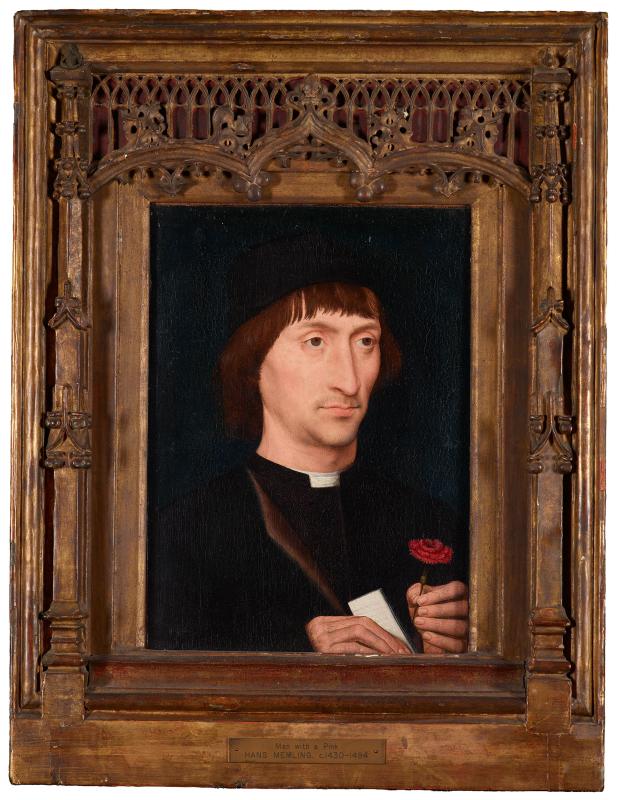
This is one of the finest paintings Morgan acquired for his personal collection. The sitter may have been a member of the Italian merchant colony in the flourishing city of Bruges, where Memling was the leading painter. He was renowned for his skills as a portraitist, and his works were particularly preferred by foreign visitors to the city, who appreciated his meticulous realism. The pink, or carnation, in the young man's hand is a symbol of betrothal, and the letter he holds in the other may be a love letter or marriage contract, suggesting that the painting commemorates an engagement or wedding. The subject of the portrait may have been a member of the Italian merchant colony living in Bruges. The pink, or carnation, in the young man's hand may be a symbol of betrothal. The painting may therefore be one of a pair of wedding portraits.
In the 1480s, Memling adopted a more painterly brushwork than in his meticulously rendered works from around 1470. For example, where the incipient beard on the chin of the earlier Portrait of a Man (Frick Collection) is indicated virtually hair by hair, Memling here uses a series of crosshatched strokes to indicate facial stubble. The effect is no less compelling. The pink held by the man is a familiar symbol of love, and this panel was almost certainly paired with a portrait of a woman and created on the occasion of a marriage or engagement. As is the case with many portraits by Memling and his contemporaries, the pigments have changed over time, merging the man's dark clothing and the background and giving the painting a more somber aspect than the original blue-green background would have. -- Exhibition Label, from "Hans Memling: Portraiture, Piety, and a Reunited Altarpiece"
Portraits of Martin Luther and His Wife, Katharina von Bora
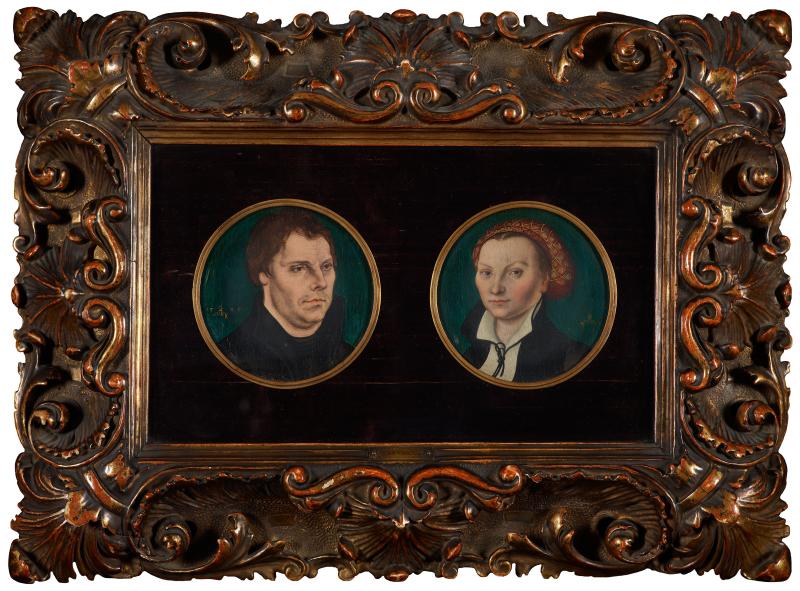
Cranach painted this pair of portraits in 1525, the year Martin Luther married Katharina von Bora, a former Cistercian nun who had escaped from her convent with Luther's help in 1523. Luther argued against the practice of celibacy within the church, asserting his belief in clerical marriage with his own union. A friend of Luther's and a witness at his wedding, Cranach thereafter became the principal portraitist of the couple.
Versions of these portraits exist in Basel and Stockholm.
Two round portraits. On the left is Martin Luther (1483-1546) and on the right his wife, Katharina Von Bora (1499-1552).
Praenestine Cista with Cover
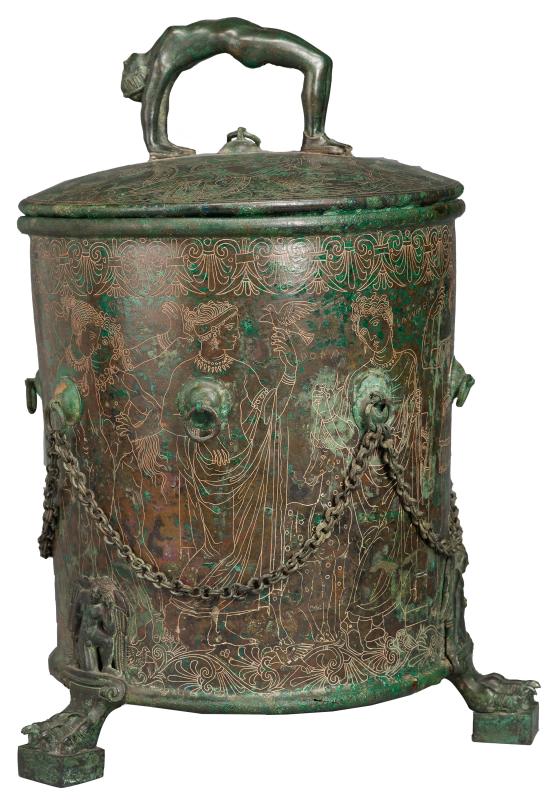
AZ046a - box; AZ046b - lid.
This piece was discovered in the excavation of Palestrina (the ancient Praeneste), near Rome, in 1864. The cista probably dates to Hellenistic period of Etruscan art, between the fourth and first centuries B.C.
The decorative engravings represent figures from ancient Greek mythology, accompanied by inscribed names in the archaic Greek and Latin of the time.
3-foot Etruscan cista with cover. The feet are in the form of a bird's paw. The handle of the cover is in the form of a female acrobat. Tiny ring on top of lid. The box has a chain looped around it. The decorative engravings on the cista represent figures, some of which are identified by engraved names suggesting a connection with the events of the Trojan War.
St. John the Baptist
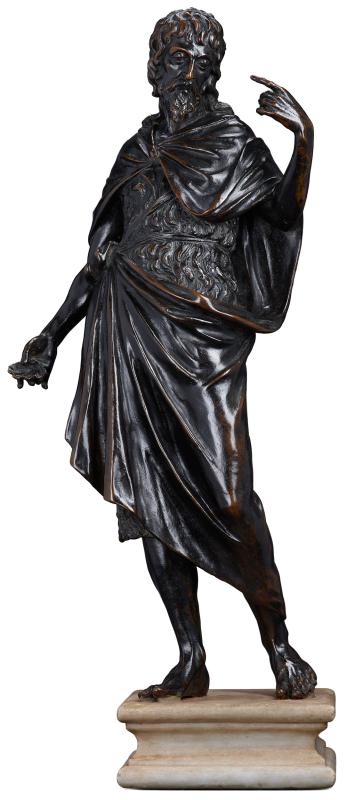
St. John, clad in an animal skin and cloak, holds in his right hand a shell, symbolic of the baptism of Christ. This cast is one of a group of at least five known variants of this figure, including ones in the Kimbell Art Museum, Ft. Worth; the St. Louis Art Museum; and a private collection on deposit at the National Gallery of Scotland, Edinburgh. It is likely that these figures, in a deliberately archaizing style and recalling the work of Michelozzo and Donatello, were cast at the very end of the sixteenth or beginning of the seventeenth century.
St. John the Baptist

A contemporary of Michelangelo and collaborator of Leonardo, the Florentine-born aristocrat Rustici was an accomplished sculptor. This statue was inspired by contemporary depictions of the saint--young, beardless, and wearing his customary hair shirt--executed by the sculptors Donatello and Benedetto da Maiano. Scholars have differed on the dating of this figure, some placing it early in Rustici's career, at the time he executed decorations for the chapel at the Villa Salviati in ca. 1512-18, and others arguing for a later date.
St. John the Baptist with a Lamb
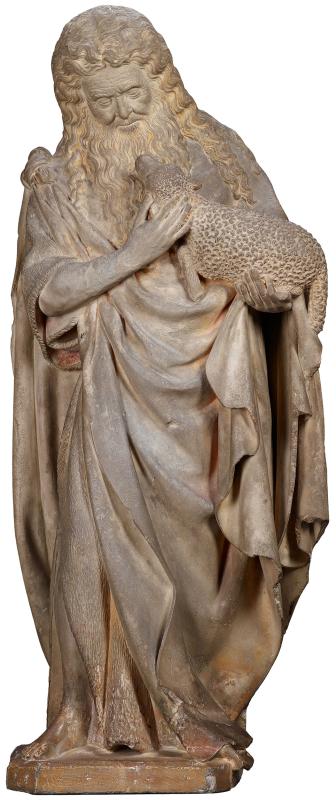
This statue reveals the impact of Sluter, a sculptor who was born in Haarlem and arrived at the Burgundy court in Dijon in 1385. The court was a center of artistic production and patronage, known especially for the naturalism of its art. The careful differentiation of textures and attention to surface detail reflect Sluter's influence and suggest that the statue is the work of a Burgundian sculptor active during the fifteenth century.
Two holes on St. John's head probably indicate the former presence of a halo. Recalls the influence of the statues of the four prophets placed around the foot of the Calvary called the "Well of Moses" in the Carthusian monastery of Champmol, Dijon.
St. John standing and holding a lamb in his arms.
Standing Virgin and Child
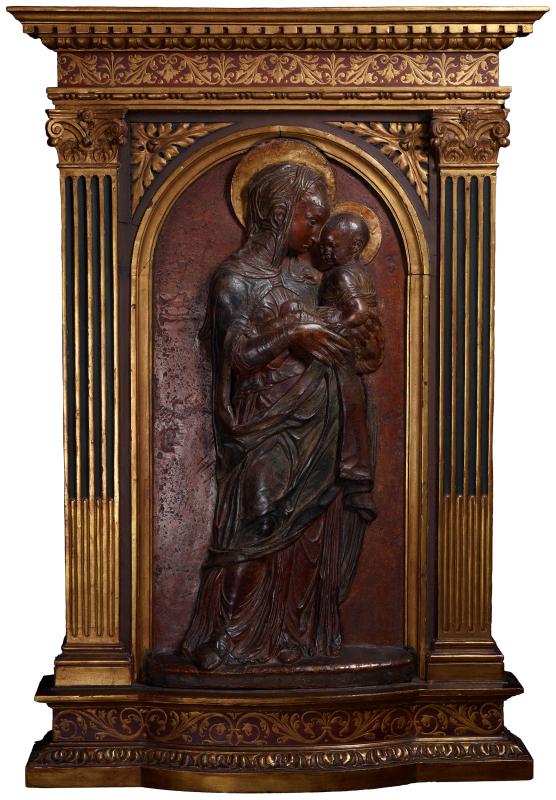
This rare depiction of the standing Virgin holding the Christ child was most likely executed by one of Donatello's followers in Padua; the figure types closely resemble those of Donatello's mature style. While numerous Italian fifteenth-century reliefs of this format survive, they usually depict the Virgin in a three-quarter pose, seated on a throne. Representations of the Virgin standing are unusual. This relief was executed in terra-cotta and then enhanced with paint and gilding.
Aimee Ng recently noted for comparison Giovanni di Turino's gilt-bronze sportello (tabernacle door) for Siena's font, which depicts a standing Virgin and Child and measures 23.2 x 47.5 cm. Giovanni's door replaced a sportello produced by Donatello that was returned to the artist in 1434. Although nothing is known of the appearance or whereabouts of Donatello's original relief, it also may have featured a standing Virgin and Child.
Stavelot Triptych
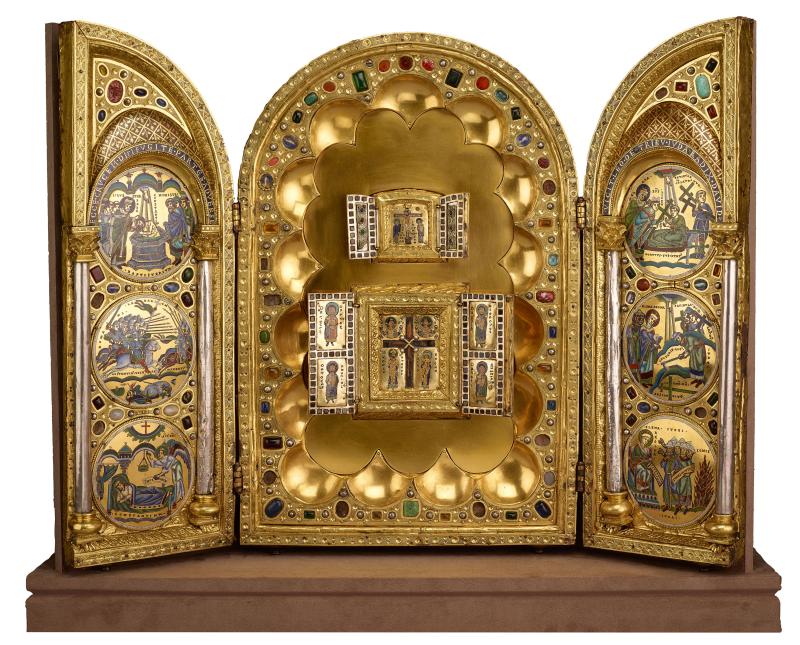
This glorious, jewel-studded triptych-a work of art in three sections-was likely commissioned in the 1150s by Wibald (1098-1158), Abbot of the Benedictine monastery of Stavelot (in present-day Belgium), as a reliquary to hold fragments of the True Cross, as well as relics from the Church of the Holy Sepulchre and remnants from the Virgin's dress. In the reliquary's central section are mounted two small Byzantine triptychs, dating from the late eleventh or early twelfth century, which Wibald probably acquired on one of his diplomatic missions to Constantinople. The most sacred of Christian relics is encased in the center of the lower triptych, decorated with two gold pins and four tiny pearls. Its two wings are adorned with figures of four Byzantine military saints, considered holy warriors. These flank the Archangels Gabriel and Michael in glory above Emperor Constantine (ca. 273-337) and his mother Helena (ca. 250-329), portrayed standing at either side of the Cross. The smaller triptych above shows Christ on the Cross attended by the Virgin Mary at left and Saint John the Evangelist at right.
The larger wings are decorated with six roundels, made by artists from the Meuse region in the ancient diocese of Liège, relating episodes in the life of Constantine and Helena. They are among the finest and best preserved twelfth-century enamels produced in a technique known as champlevé, in which the vitreous enamel is contained in cavities hollowed out of a thick copper plate. Reading from bottom left, we see the sleeping Emperor Constantine to whom an angel appears in a dream telling him to go into battle under the sign of the True Cross (“By This, Conquer.”). Above, Constantine and his army are shown defeating Emperor Maxentius in battle at the Milvian Bridge in 312 AD. At upper left Constantine is baptized by Pope Silvester. The roundels on the right-hand panel are devoted to Helena's discovery of the True Cross in Jerusalem. Again, starting at the bottom, we see her interrogating by fire a group of Jews who inform her that a certain Judas knows the location of the Cross. In the roundel above, the aforementioned Judas is shown excavating the three crosses at Golgotha. At upper right, a bishop (Makarios?)-shown next to Saint Helena, crowned by a double tiara-identifies the True Cross when it miraculously restores the seated young man to life. The Abbot of Stavelot served as an adviser and agent for three successive Holy Roman Emperors and was a fervent supporter of the Second Crusade. Evoking the majesty of the Heavenly Jerusalem, the Stavelot Triptych also championed the cause of maintaining Christian control of the earthly city itself.
The Abbot of Stavelot served as an adviser and agent for three successive Holy Roman Emperors and was a fervent supporter of the Second Crusade. Evoking the majesty of the Heavenly Jerusalem, the Stavelot Triptych also championed the cause of maintaining Christian control of the earthly city itself.
Central panel - contains two Byzantine triptychs. The upper triptych depicts the Annunciation and the Crucifixion. The lower triptych depicts the four Evangelists, four Byzantine military saints, and Constantine and Helena flanking the relics of the True Cross. Wings - contain six enamel medallions (three in each wing) telling the legend of the True Cross.
The upper Byzantine triptych depicts the Annunciation (outer wings) and Mary and John beside the Crucifixion (center panel). The lower Byzantine triptych depicts the four Evangelists (outer wings), four Byzantine military saints (inner wings): George and Procopius on the left, Theodore and Demetrius on the right. In the center, beneath busts of the Archangels Gabriel and Michael, and flanking the True Cross composed of the relic itself, are Emperor Constantine and his mother, Empress Helena. The wings contain six enamel medallions (three in each wing) telling the legend of the True Cross.
Stemmed Cup with Two Handles
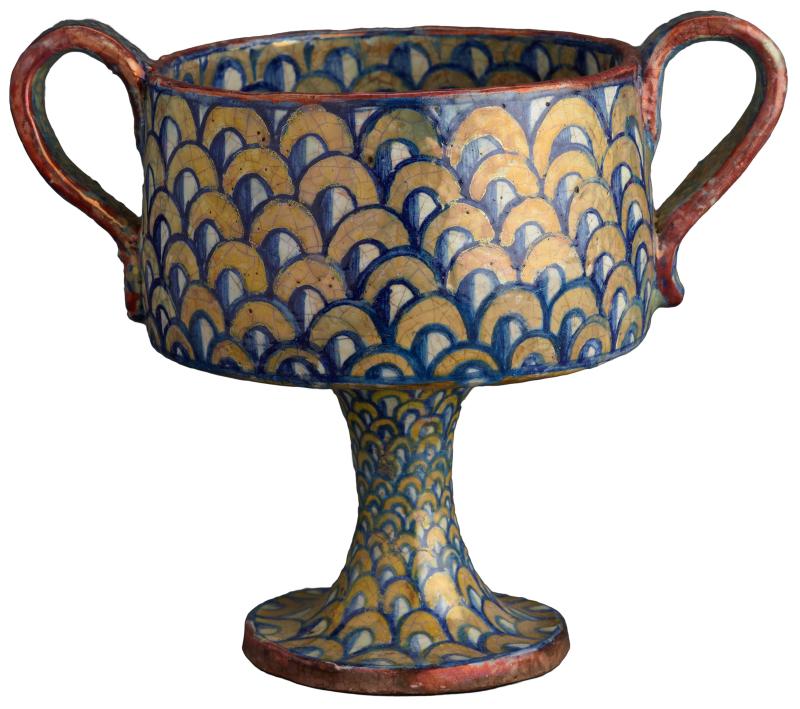
This stemmed cup bears the scale ornamentation characteristic of pottery from Deruta, a center of Renaissance majolica in Umbria. The light-colored earthenware is covered with opaque lead glaze, here set off by brilliant copper-luster borders. Greek deities of fertility - Artemis, Demeter, and Triptolemus - and their serpent attendants are depicted on the interior at the base of the cup.
The Adoration of the Magi

Companion of the "Death of the Virgin" panel, AZ022.2.
Crafted at the court of Holy Roman Emperor Charles iv (r. 1346-78) at Prague, these exquisite panels (AZ022.1-2) likely formed a diptych-commissioned perhaps by the emperor himself. In the scene of the three kings adoring the Christ child, the second magus has the features of Charles, and his red cloak bears the imperial eagle. In the panel depicting the Virgin's death, St. Peter wears the three-tiered papal tiara. These details allude to the delicate balance between sacred and terrestrial power.
Gilded layer of wood panel punched and incised.
The three Wise Kings offering their gifts to the Virgin and Child. St. Joseph is kneeling in front of the Virgin. In the upper right corner is the Annunciation to the Shepherds.
The Dormition of the Virgin
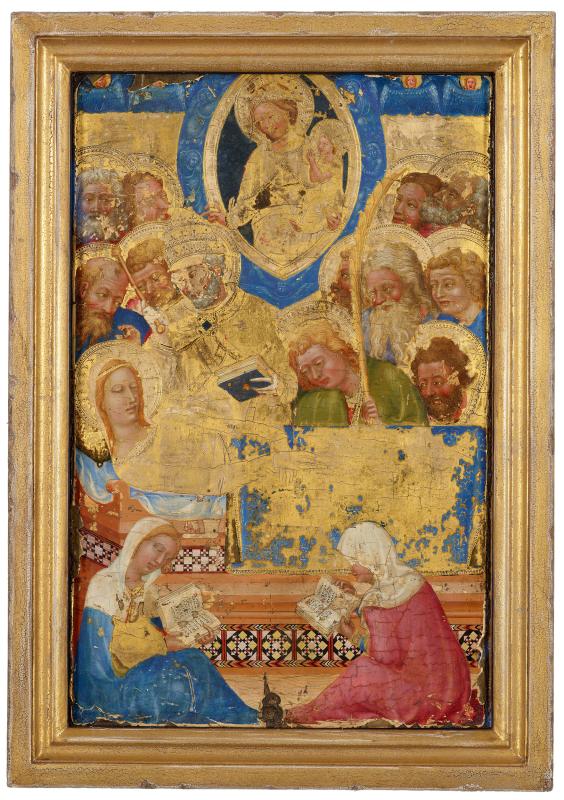
Companion of the "Adoration of the Magi" panel, AZ022.1.
Crafted at the court of Holy Roman Emperor Charles iv (r. 1346-78) at Prague, these exquisite panels (AZ022.1-2) likely formed a diptych-commissioned perhaps by the emperor himself. In the scene of the three kings adoring the Christ child, the second magus has the features of Charles, and his red cloak bears the imperial eagle. In the panel depicting the Virgin's death, St. Peter wears the three-tiered papal tiara. These details allude to the delicate balance between sacred and terrestrial power.
Virgin on her death bed surrounded by different saints. An angel holds a palm. St. Peter is shown officiating at the funeral and is represented wearing the triple-crowned papal tiara. The Virgin and Child from heaven, upper center of the painting, observe the scene.
Verrazzano Globe
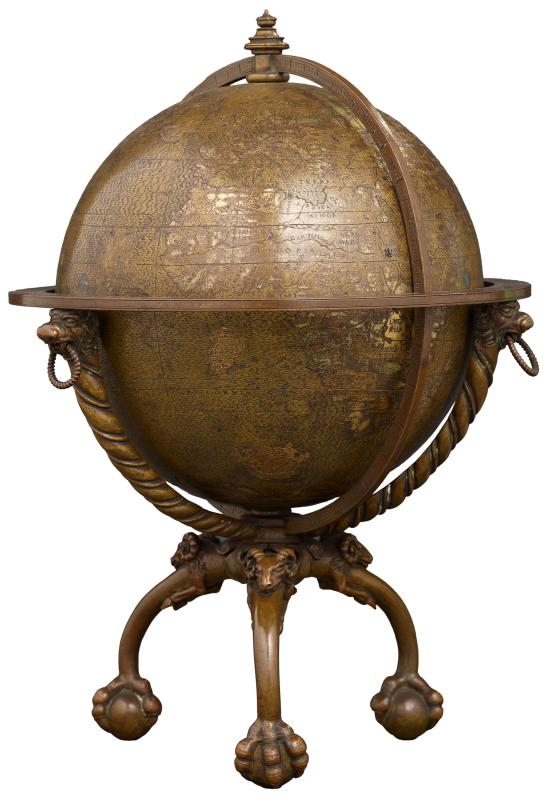
One of the earliest dated globes, this gilded sphere depicts the world as known from the explorations of Giovanni da Verrazzano (1485-1528), who journeyed to the New World in 1524. He sailed along the coast from South Carolina to Newfoundland, becoming the first European since the Norse colonizers of ca. 1000 to visit New York and Narragansett Bay. The globe, executed by sculptor Robertus de Bailly in 1530, was based on a 1529 map by Verrazzano's brother, Gerolamo. Like the map, it identifies the newly charted North American continent as Verrazana.
America bears the name "America" and "Mondus Novus," and is divided into 4 parts: North, Central and South America, and the Archipelago.
The following names of American towns, rivers, etc., occur: Terra Laboratoris, Bachaliao, VERRAZANA, Laelopida, R. S. Spy, R. D. Palma, P. Disavio, R. Gpao, Cannibales, Terra sacecrvis, R. Real, R. Brazil, Tanacnoi, S. Michaelis, Tenvtista, Colva cana, R. D. Crisai; R. D. Gra, C. Frio, Barossa, Ms. Pasqva, R. Jovrda, Terra Magellani, Canano, S. Julia, Parias, Vrabe, Oabaiba, R. Formo, Angia, R. Dvlce, Co. Crvi, Catticora, Yvcatas, Cvba, Spagnola, S. Joha. The Continent lying opposite the southern point of America is called BRASILIE REGIO. Result of Verrazzano's travels are marked by TERRA VERRAZZANA.
Dr. E.L. Stevenson states that this is "one of the finest metal globes of the period." It is one of the two earliest dated globes known; the other is said by Harrisse to be at the Bibliothèque Nationale de France.
Virgin and Child Blessing a Kneeling Donor, with Four Saints

Attributed to Marco Bello, a member of Bellini's prolific Venetian workshop, this painting was likely based on different models developed by the master. This would account for the lack of consistency in scale and placement in space of the beautifully conceived figures. The saints depicted include (left to right) Paul, George, an unidentified female saint, and an unidentified martyr, perhaps St. Cecilia, with a wreath and palm. The devotional subject and presence of a donor portrait indicate that this was a private commission.
Virgin and Child Enthroned with God the Father and Six Angels

Virgin and Child with Cherubim
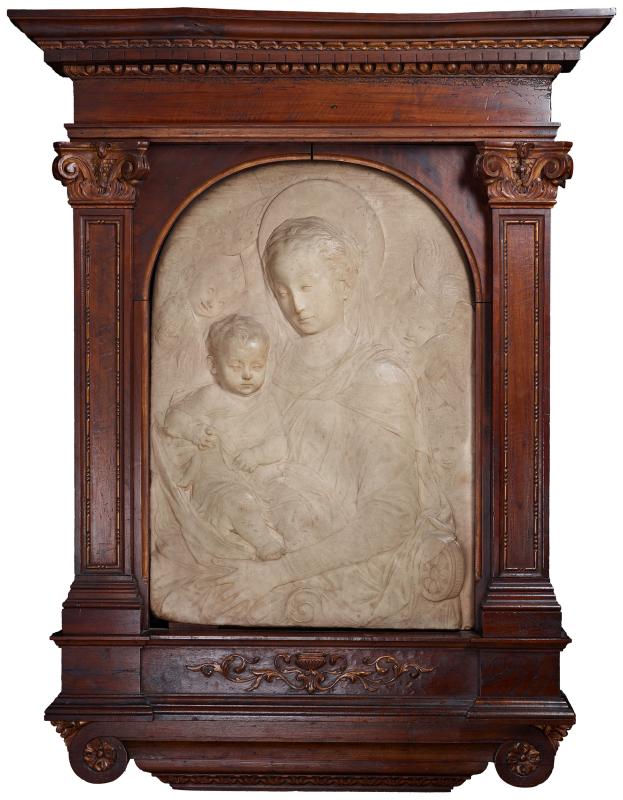
Seated on a heavenly throne, with three lively angels behind her-two at left, one at right-the Virgin holds the Christ Child in a gentle, protective embrace. Shown in a three-quarter pose, she supports the infant underneath his shoulder with her right hand, steadying him as he sits on her lap. The Christ Child places his right foot on his mother's left wrist, and rests his toes on her embroidered cuff. Mother and son look in different directions, with the Christ Child casting his gaze on the viewer directly below. A masterpiece of Florentine Renaissance devotional sculpture, this marble was likely made for a domestic setting, although we do not know who commissioned it. (The frame was likely added in the nineteenth century.) Antonio Rossellino carved Virgin and Child with Cherubim partly in low relief, in a technique known as rilievo schiacciato (literally, “flattened relief”), with finely engraved, chiseled lines in the background. The heads of the Virgin and Child are fully modeled and emerge from the delicately rendered details. As was customary with this sort of relief sculpture, the most fully worked areas of the composition, such as the arm of the throne and the Virgin's left hand, are to be found in the lower section, which would have been closest to the viewer looking up at the wall-mounted object. Rossellino had encountered Donatello's innovative naturalism in the 1450s and absorbed the older sculptor's example of imbuing the carving of marble with pictorial effects. Note, for example, the Virgin's braided coiffure, the diaphanous veil that falls from her hair, and the folds of her garment, into which the fingers of her left hand disappear.
Virgin and Child with SS. Catherine and John the Baptist

While the Christ child leans back to play with St. John the Baptist's cross, the Virgin proffers a golden ring to St. Catherine of Alexandria, alluding to the saint's mystic marriage to Christ. Cima asserted his authorship of the painting on the small piece of paper (cartellino) affixed to the parapet in the foreground, an element considered a signature of his work. The panel formerly belonged to Charles Fairfax Murray (1849-1919), the pre-Raphaelite painter and collector from whom Morgan purchased his collection of old master drawings in 1909.
The painting is of a type known as the sacra conversazione, or sacred conversation, in which the Virgin and Child are shown in the company of saints.
The frame is gilded and carved wood. The wooden label on bottom center of frame reads: "Cima da Conegliano - From the Birch - D. Watts Russell and Fairfax Murray Collections."
Virgin and Child between St. John the Baptist (at her left) and St. Catherine (at her right). Saint Catherine holds a palm in her proper left hand. Mary holds a ring in her proper right hand.
Virgin and Child with SS. Dominic and Barbara
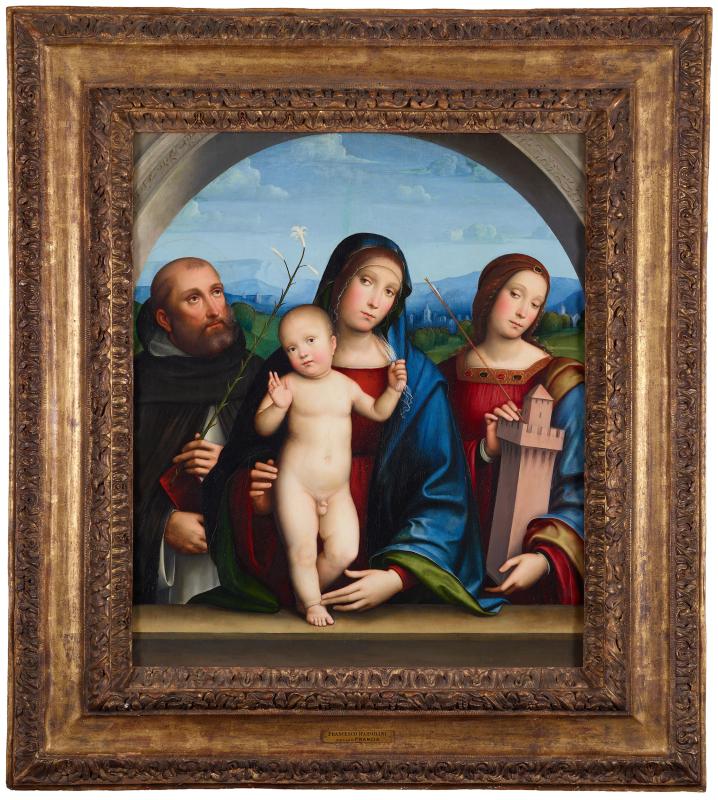
Although trained as a goldsmith, Francia primarily worked as a painter in and around his hometown of Bologna. Depictions of the Virgin and child with saints are predominant among his major surviving works. St. Barbara is shown with a martyr's palm and a model of the tower in which her pagan father imprisoned her, while St. Dominic, the founder of the Dominican order, wears his black and white habit and holds a lily and a book. When Francia painted the present panel, he was influenced by the luminous style of his contemporary Perugino, another artist represented in Morgan's study.
The Virgin and Child with S. Dominic at her right and Saint Barbara at her left. St. Barbara is holding an arrow and a tower. S. Dominic holds a lily and a book. He wears the religious garb of the Domenican order.
The lily may signify St. Dominic's purity while the tower represents St. Barbara's martyrdom, her incarceration by her father.
Virgin and Saints Adoring the Christ Child
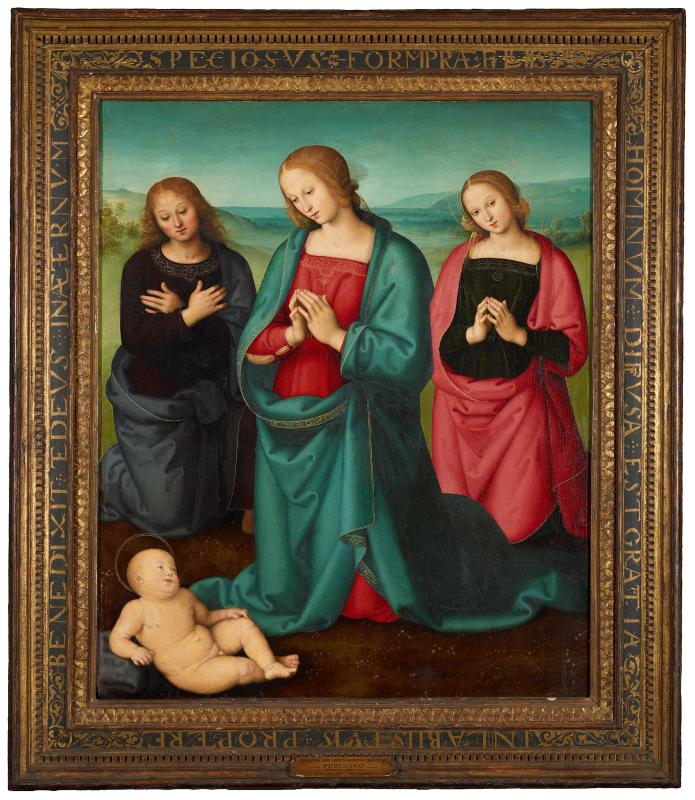
Known for his graceful figures, Perugino, the leading Umbrian painter of his day, was Raphael's principal master. Using harmonious jewel-like tones, the artist depicted the Virgin flanked by St. John the Evangelist and an unidentified female saint, likely Mary Magdalene. The inscription on the frame, referring to the Christ child, is from Psalm 45: Fairer in beauty are you than the sons of men; grace is poured out upon they lips; thus God has blessed you forever.
The painting depicts the Virgin adoring the Christ child flanked by two saints. The male saint to the left is probably St. John the Evangelist. The female saint to the right has not been convincingly identified. She is generally thought to be the Magdalene, but also has been identified as St. Sophronia based on a reading of the partial inscription on her halo. It has recently been suggested by William Voelkle that this inscription is not a name, but the phrase "Ora pro nobis".
Virtue Punishing Vice
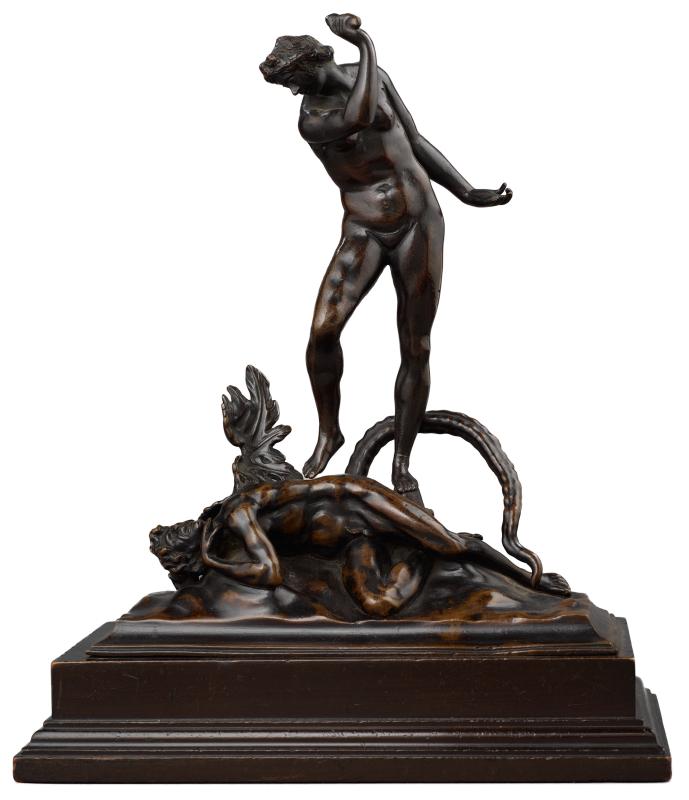
A number of casts then believed to be after Benevenuto Cellini's Virtue Punishing Vice were sold to American collectors in the early years of the twentieth century (see a similar cast in the National Gallery of Art, Washington). In 1914, when Morgan's collection was exhibited at the Metropolitan Museum of Art, it was described as "almost certainly the work of the master."
The original model for the bronze group is Pierino da Vinci's statuette of Virtue and Vice, ca. 1550 (for example, see a cast in the Victoria & Albert Museum). The present bronze lacks the club wielded by the figure of Vice, although she holds the stub of the instrument in her raised hand. The devil's wings are more elaborate than in other casts (see for example, the cast in the Bode Museum, Berlin), and the addition of an elaborately sinuous tail is remarkable. Other details suggest the present work is a late cast that has been embellished, not the least of which is the awkward placement of the figure's right arm and hand. It is entirely possible that the cast dates to the early nineteenth century if it was indeed in the Hayden family collection for around eighty years as claimed by Francis Seymour Haden.
Woman (Virtue) stepping on male winged figure with a tail (Vice).